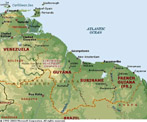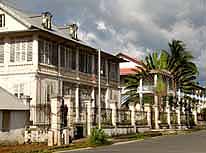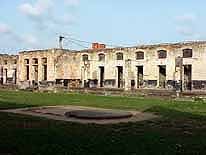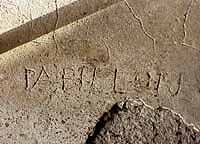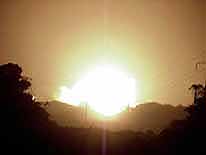Enjoy some pictures of the worldrecordtour, taken in French Guiana
|
|
click a picture to see details |
|
|
|
||
|
|
|
|
|
|||
|
|
|
|
|
|||
|
|
|
|
| Since our last visit in April 2003, hardly anything has changed in this small border town of Saint Laurent, which lies picturesquely at the mighty Maroni River. Long, narrow wooden canoes still are lined up along the river shore, with “captains” fighting for each passenger. Young and old still gather in the fresher evening hours to chat, drink and celebrate. Song birds – tiny finches - are still hanging on poles everywhere in their little cages, which were trained as song birds. And the border police still are chasing every day illegal immigrants from Suriname and former British Guyana who are smuggled somewhere across the river together with barrels of fuel and everyday necessities – eggs, potatoes, onions, garlic, flavor, Maggi cubes etc. The merchandise is shifted to wheel barrows and sold along the road or hauled through the streets by black women, offering like this house delivery service as in nostalgic times.
|
|||
|
|
|
|
| The most picturesque, however, are the colorful, lively market days. Piles of orange colored mangoes are just besides green papaws. Green and yellow bananas next to giant pineapples and passion fruits with their gray pits shining like glass pearls. It is really amazing how plentiful, garden fresh and of first quality the vegetables and fruits are, which are cultivated mainly by the Hmong farmers - Laotian refugees who arrived in the seventies and settled down in the villages of Javouhey and Cacao. Interesting is that there is no bargaining at all, nor with the Blacks, nor with the Asians. My favorite vendor is an old, very short and very slim Hmong. Mostly I buy green salad – seven small ones for 2 Euros – four wonderfully sweet papaws for the same amount and a whole net of seedless lemons for 1 Euro. These products are now in season and inexpensive.
|
|||
|
|
|
|
| But everything else which is imported from France – and most other stuff is coming from there - is extremely expensive – at least for us, but not so much for the French from the mainland working here, because they are paid 40% more than in the “Métropole”. The locals earn – even without working - a minimum salary of Euros 400, and with plenty of children the allowances can even exceed €3000. No wonder that the number of children is extremely high. On our daily walk through the township called “Charbonnière” to our car parking, the streets overflow with happy, sometimes naked children playing all kind of simple games. One of their favorite seems to be pulling themselves around with empty garbage bins. We also see many young girls pushing wheel barrows full of dirty crockery to the river to do the dishes. Although it is not a genuine African lifestyle anymore, a flame of it is still present, with one big exception that practically in front of each house there is an own car parked!
|
|||
|
|
|
|
|
|||
|
|
|
|
| Following the history in the well illustrated museum, visiting the single and communal cells picturing the hard life of the prisoners, and listening to the emotional explanations of our brilliant guide about the executions with the Guillotine, we really get goose pimples. For example all prisoners were forced to knee down and watch each beheading until the cruel end. Closing the eyes or bowing the head was punished severely. Some heads of executed fellow prisoners were preserved and exhibited in the hospital as a warning. But also what we hear about the life in the “Blockhouse” – the communal cell – is hair rising. In this small room up to 50 detainees were chained at their feet for 22 hours each day. Only during the two remaining hours they had the possibility to visit the bathroom. It is hard to imagine the penetrating smell in this room when some could not resist “the call of nature”.
|
|||
|
|
|
|
| But this was still more “human” than the destiny of those with severe punishments or political prisoners, who were expelled to single imprisonment with no return to the Îles-du-Salut (Royale, Diable and St-Joseph). On the wild, hot, humid and rainy island of St. Joseph, the tiny cells did not even have a roof, only iron bars, exposing the deportees constantly to all weather conditions and without mercy also to the attentive eyes of their merciless guards. Today, the ruins of this “green guillotine” are slowly been taken over by the jungle again. What will remain is a lonely group of islands covered with palm trees, raged by the ocean waves – a little tropical paradise. We could not make up our mind immediately if we should visit the Îles-du-Salut, lying 10 miles offshore of Kourou, as a trip with a Catamaran costs Euro 49 per person. But the desire to see the place, where famous “Papillon” finally made his sensational escape to Venezuela, succeeded.
|
|||
|
|
|
|
| But there is also something else in St. Laurent, something for the enjoyment and the heart: To watch the giant “Leatherback” turtles emerging from the sea to lay their eggs. And here, we are at the right time at the right place, because each year, from March to July, these turtles arrive at the beach of Les Hattes at Yalimpo, an Amerindian village, for reproduction. It is said to be one of the most important hatching places in the world. We are very anxious to get started, but have to wait for the right time, as they are swept ashore with the high tide. Finally, the moment is perfect. We take our torches and insect repellent and drive the 40 miles to the beach. It does not take long until we discover the first one which heaved herself already far enough away from the water to protect the eggs from incoming floods and just starts to dig a deep hole with her powerful rear fins. We hardly dare to move, as we watch her. Suddenly, her first egg appears and approximately ten minutes later one after the other rolls into the soft sand hole. We count around a hundred; most of them are a little bigger than a golf ball. As soon as she has finished lying, she consciously refills her nest with sand again still by using her rear fins and hardening the sand now and then by tapping gently. Finally, to eliminate all traces, she makes swimming movements with her huge front fins before she then hauls herself a little further, turns towards the black sea and disappears in the dark waves of the Atlantic again.
|
|||
|
|
|
|
| The whole process took two hours. We are as impressed and deeply touched by the hard and difficult instinctive reproduction ritual of these endangered animals as we were with the salmons in Alaska , the more that here it is repeated seven times each season. But we are also worryingly aware that only a few will have a chance to survive in two months time (statistically only two out of about 100) what makes us really sad and frustrated. 1992 they counted still 50’000 of these species on this beach, today they have been reduced to half as much. The eggs’ main predators are wild dogs, but also unscrupulous people who collect them either for eating or selling them illegally on the market. By the way: The “Leatherback” can reach a length of up to seven feet and weigh up to 2’000 pounds. The six we saw tonight were about five feet and 500 pounds.
|
|||
|
|
|
|
| Kourou, the European Space Center, is situated 125 miles from Saint Laurent. It is known also as the “White City” due to the approx. 3’000 citizens from the French mainland working mainly in the Space Center. Two years ago, on April 9th, 2003, luck had it that we were just at the right time at the right place again, when an Ariane 5 rocket launch was planned. But our anticipation to be able to watch shrinks soon as we hear that all visitor seats are already booked out. May be we still have a chance despite the very long waiting list? No matter what, we add our names too. Of course, we are not the only ones with a little hope. Suddenly, names are called up, fortunately also ours – we are among the lucky ones! Soon there are happy faces all over, as due to the many “no shows” no one has to stay back and all are able to board the buses driving us to the “Agami Point”, which is 4 miles from launching pad.
|
|||
|
|
|
|
| The rocket is brightly illuminated, as we arrive, and on the giant screen we are able to follow the last preparations. Then, the excitement of the “countdown” takes over. All of a sudden, the 400 visitors become silent. Exactly on time, Ariane 5 ignites and lifts after a few seconds slowly and majestically like a flare towards the nightly sky, where it soon disappears behind the clouds. After a few more seconds, an intense and heavy thundering blast rumbles, the ground is trembling and all the jungle noises disappear for a few minutes. After the thrill is receding a little, we hear that the mission was successful. Enjoyment is all over, clapping hands are everywhere. Why was the tiny jungle country of French Guiana the choice for the European Space Center, we ask ourselves. We get the answer the following day at the very informative, three hours lasting sightseeing tour, which by the way is free of charge: 1. It is due to the extremely favorable vicinity to the equator (full use of the earth movement). 2. The proximity to the ocean (boosters fall into the sea). 3. The scarce population (nobody has to be evacuated at a launch). 4. The big emptiness and uncultivated land. It is interesting to note that in order to protect the expensive installations in case of a sudden crash or explosion all the constructions have been built distantly from each other.
|
|||
|
|
|
|
| Finally, we reach Cayenne, the capital, which is only 40 miles away from Kourou. Will we now continue to Brazil or does the wind blow us in another direction? This is the very substantial question, which is in our mind since weeks. A two hours visit at the Assistant Manager’s office of CMA-CGM – the big French shipping line - is enough to make us all excited: Our dream to return again to Southeast Asia to explore new countries becomes suddenly reality. It’s another proof, that the French, who in earlier times we judged to be rather arrogant and distant, are different here in French Guiana. They are helpful, warm-hearted, hospitable, interested and open and have in a way still a touch of an adventurous spirit. We found open doors very easily: Philippe in Saint Laurent offered us his two room apartment for three weeks; the Birebent and Marsy families in Kourou invited us to sleep in their houses. Xavier, who traveled years ago the world in a motorbike with side car, and Francine and Philippe, all were our caring and attentive hosts in Cayenne. It is just all those contacts, which are enriching our journey around the world always so magnificently.
|
|||
|
|
|
|
| As we say good-bye to French Guiana and the three Guyana’s altogether on July 29th, we recall with melancholy and appreciation all the hospitable people, the colorful mixture of ethnic groups with all their cultures, way of lives and religions, the mysteries of the rain forest, our adventurous jungle journeys with its black rivers and the calls of exotic birds, which always will make us dream. But we shall never forget also our early breakfasts near the Hotel “Les Roches” in Kourou, where we watched with fascination for many days every morning the catamarans setting the sails for the offshore islands of “Îles-du-Salut”. We spent many weeks in this very special region and enjoyed every day of it. Even we developed a certain love and a certain “feeling at home” for it. Therefore, in order to make our departure not too abrupt, we cross the three Guyanas for a third time, now the opposite way from Cayenne to Georgetown in crowded minibuses, while our LandCruiser is sailing lonely on the oceans to its new destination – Singapore. At 5am of August 4th, our departure day dawns definitely: With moist eyes and with sadness we board in Georgetown the BWIA flight towards Miami. Above us clouds form dramatically surreal sculptures, and below us the first morning light is hitting the immense carpet of one of the few remaining virgin rain forests in the world with its mighty, meandering rivers, leaving an emotional impression of this remote place in the Northeastern corner of South America, which will always cover a special place in our memories.
|
|||
|
|
|
|
|
|||

